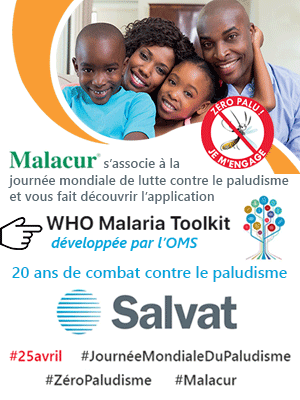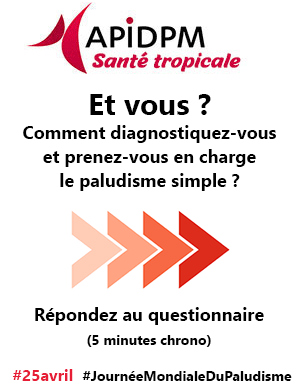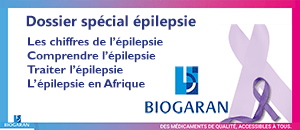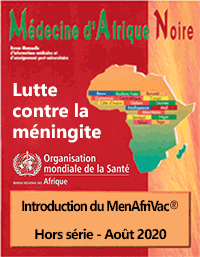
Le guide de la médecine et de la santé
en Afrique francophone
Suivez-nous :
 Identifiez-vous | Inscription
Identifiez-vous | Inscription

Suivez-nous :
 Identifiez-vous | Inscription
Identifiez-vous | Inscription

Publié dans Médecine d'Afrique Noire 6301 - Janvier 2016 - pages 23-34
 Prise en charge des anémies chez les patients cancéreux dans un hôpital de référence de Douala, Cameroun
Article Open access
Prise en charge des anémies chez les patients cancéreux dans un hôpital de référence de Douala, Cameroun
Article Open access
Auteurs : N.E. Essomba, G.P. Ngaba, E.H.M. Dina Bell, N. Ngo Tedga, D.C. KedyKoum, A. Mouelle Sone, Y. Coppieters - Cameroun
Introduction : L’anémie représente un facteur limitant dans la prise en charge des patients cancéreux. L’objectif général de ce travail était d’évaluer la prise en charge de l’anémie chez les patients cancéreux reçus à l’hôpital général de Douala, par rapport aux recommandations internationales.
Patients et méthodes : Il s’agit d’une étude prospective menée du 1er septembre 2013 au 30 avril 2014. La sévérité de l’anémie après traitement spécifique a été évaluée à l’aide du classement OMS des grades de toxicité hématologique chimio-induite. La qualité de vie des patients a été évaluée grâce au score OMS du Performance status. La prise charge de l’anémie a été comparée aux standard options et recommandations françaises 2007.
Résultats : Au total 301 patients ont été colligés. L’âge médian était de 42,5 ± 15,1. La prévalence de l’anémie à l’entrée était de 71,4% et passait à 80,7% après traitement. Tous les cancers ont été pourvoyeurs d’anémie sans différence statistiquement significative. Le taux d’abstention thérapeutique était de 16,9% avant l’initiation du traitement spécifique et de 13,6% après. Les anémies légères ≥ 10g/dl ont été traitées par fer oral. Les anémies modérées à sévères ont été traitées par transfusion sanguine. Les agents stimulants de l’érythropoïétine ont été utilisés dans 2,3% des cas. Le taux de respect des recommandations était de 17,5%.
Conclusion : Cette prise en charge conformément aux recommandations internationales reste insuffisante. Elle se heurte à plusieurs obstacles dont le principal est financier, ainsi qu’à la rareté des médicaments. Un plaidoyer pour une subvention de médicaments sur cette problématique est à développer.
Introduction: Anemia is a limiting factor in the management of cancer patients because of the deterioration of the quality of life. The overall objective of this study was to evaluate the treatment of anemia in cancer patients received at the General Hospital of Douala, in accordance with international recommendations in order to improve current practices of physicians.
Patients and methods: We carry out a prospective study from September 1st 2013 to April 30th 2014 in the Radiotherapy and Oncology Department of the Douala General Hospital. Were included, any cancer patient, followed in our department during the study period. The severity of anemia after specific treatment was assessed using the WHO-classification grade of chemotherapy-induced haematological toxicity. The quality of life of patients was assessed using the WHO Performance Status score. The management of anemia was compared with French standard options and recommendations (SOR) 2007. The Chi2 Pearson test was used for any comparison.
Results: A total of 301 patients were registered, including 228 women (75.74%) and 73 men (24.25%). The median age was 42, 5 ± 15.1. The prevalence of anemia at entry was 71.4% and incidence after administration of a specific treatment (one cycle of chemotherapy or total doses of radiation) was 80.7%. Anemia was found in all types of cancers. The therapeutic abstention rate was 16.9% before initiation of specific treatment and 13.6% after. Mild anemia ≥ 10 g/dL were treated with oral iron. Moderate to severe anemia were treated with blood transfusion. ESA were used in 2.3% of cases (5 patients). The rate of using international guidelines was 17.5%.
Conclusion: The respect of international guidelines for the management of anemia in cancer patients is low. The main obstacle is the financial issue.
 Lire l'article (PDF)
Article Open access
Lire l'article (PDF)
Article Open access
Cet article est actuellement coté ![]() (1,0 étoiles) par les abonnés de APIDPM Santé tropicale.
(1,0 étoiles) par les abonnés de APIDPM Santé tropicale.
Il a été consulté 3450 fois, téléchargé 48 fois et évalué 1 fois.
Retour - Sommaire de ce numéro










![]() Adresse
Adresse
![]() Téléphone
Téléphone
Revue MAN
Revue OST
Actualités
Webinaires
Espaces labos